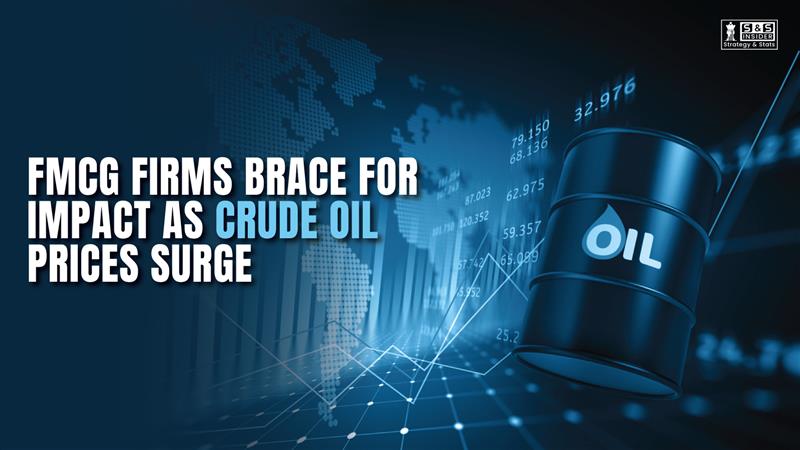
Crude Oil’s Rising Tide and FMCG’s Cost Waters:
Geopolitical tensions in West Asia and worries about supply shortages have been major factors in the recent steady increase in the price of crude oil worldwide. Global Fast-Moving Consumer Goods (FMCG) corporations are under a lot of financial strain as a result. A lot of these businesses are already worried that rising crude oil prices would cause input costs to rise. The explanation is straightforward: petroleum-linked derivatives account for a significant amount of FMCG production costs. Because they rely so significantly on petrochemical feedstocks, packaging materials like plastics, laminates, and films are susceptible to changes in the price of oil. Similarly, margins are further strained when freight and logistical costs increase in line with rising fuel prices.
FMCG companies are therefore compelled to decide whether to absorb the higher costs internally, pass them on to customers, or come up with creative ways to cut operating expenses when crude oil prices rise. Because every decision has some risk, the majority of businesses are currently taking a cautious "wait-and-watch" stance.
The Wait-and-Watch Posture: Balancing Risk and Reaction
Before deciding on any significant price changes, top FMCG businesses in India and overseas keep a careful eye on the state of crude oil. Businesses are reluctant to raise retail prices right away, despite growing cost pressures. They understand that if expenses are passed on to customers too soon, demand may suffer, particularly in very price-sensitive sectors.
According to industry figures, freight and packaging can make up about one-fifth of an FMCG company's overall expenses. Any significant rise in these costs has the potential to rapidly reduce profitability. Businesses are aware, nevertheless, that oil prices can fluctuate; a sharp increase one day might be followed by a decline the next. Therefore, if costs normalize, early price rises may backfire. FMCG companies are attempting to find a balance between preserving consumer trust and preserving profitability by adopting a wait-and-watch approach.
Pressure Points Within the FMCG Ecosystem:
Packaging is the first and most important area of consideration. Every increase in the price of crude oil directly raises packaging costs because a significant portion of FMCG packaging is made of materials generated from oil. Businesses that use plastic sachets, laminated packets, or containers are especially vulnerable to this tendency. The next significant cost factor is freight and logistics. The cost of transporting both raw supplies and completed commodities increases with rising fuel prices, which raises supply chain costs.
Furthermore, customer demand is still a sensitive element.
FMCG products frequently meet basic daily necessities, and even a slight price increase can cause noticeable changes in consumer behavior. To control household budgets, consumers may choose to down-trade to less expensive brands, move to private labels, or choose lower box sizes. Aggressive price increases are therefore dangerous. A further layer of complexity is introduced by competitive dynamics. One company runs the risk of losing market share if it raises pricing while others stay the same. However, margin erosion can also result from postponing price changes over an extended period of time.
Strategic Responses: How FMCG Firms Are Managing the Challenge
Many FMCG companies are using forward contracts and hedging techniques to deal with these challenges. They can guard against short-term volatility by using these financial techniques to lock in raw material prices for a few months. They can monitor crude oil trends and determine whether price increases are required later thanks to this breathing room.
Cost effectiveness is another strategic lever. In order to find savings, businesses are reanalyzing their supply chains, streamlining transportation, cutting waste, and investigating alternative packaging materials that are less reliant on petroleum derivatives. To keep consumer price points consistent while preserving margins, some businesses are also experimenting with lower product quantities or changing the grammar.
FMCG companies frequently favor gradual pass-throughs over significant, abrupt price rises when they are unavoidable. Customers' astonishment is lessened and brand loyalty is maintained when price increases are spaced out over time. Before making any significant pricing decisions, businesses simultaneously keep an eye on consumer mood, competitor pricing trends, and demand data.
The long-term solution is also starting to include innovation and sustainability. Businesses are looking at recyclable and bio-based packaging options because they may lessen their reliance on petroleum-based materials and satisfy consumer demands for environmentally friendly goods while also complying with changing environmental requirements.
Implications for Investors and Market Watchers:
The recent spike in crude oil prices is a crucial sign of FMCG profitability in the near future for investors. Narrower margins are usually the result of rising oil costs unless businesses can balance them with efficiency gains or incremental price hikes. To evaluate how well FMCG companies are handling the pressure, market experts are keeping a careful eye on consumer demand elasticity, freight cost statistics, and packaging material indexes. When oil prices stabilize, businesses who can sustain margins without implementing drastic price increases may gain a competitive edge.
However, even the best-run businesses may face difficulties if oil prices remain high for an extended length of time. In order to maintain profitability, they may need to reevaluate their pricing policies or reduce marketing and distribution expenses.
Conclusion:
The FMCG sector is at a critical juncture as a result of the global increase in crude oil storage prices. Although there is no denying the strain on raw materials, packaging, and logistics, businesses are sensibly taking a cautious approach rather than responding quickly. The "wait-and-watch" approach is indicative of a mature strategy that strikes a compromise between immediate cost concerns and long-term customer loyalty and brand equity.
In the end, FMCG companies' flexibility, inventiveness, and operational discipline will determine their capacity to handle this unpredictability. Businesses that have made investments in efficiency, substitute materials, and more intelligent pricing strategies will fare better if crude prices stay high for an extended length of time. Adaptability, not speed, will determine the FMCG industry's victors in an era of volatile oil prices.